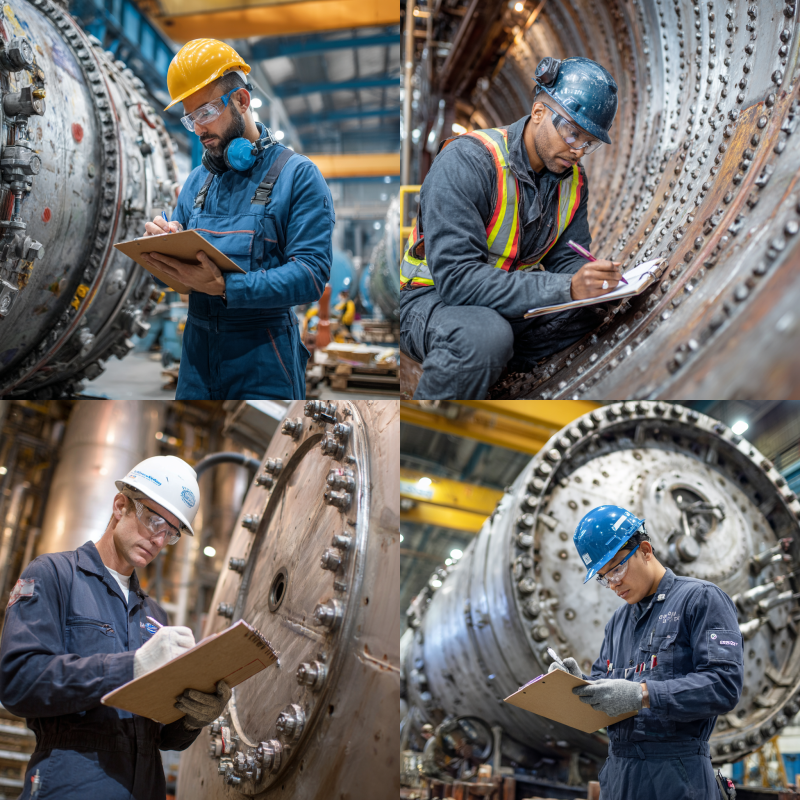
Smart Strategies on How to Choose Materials for Pressure Vessels
How to Choose Materials for Pressure Vessels
Your choice of materials for a pressure vessel can make or break the safety and longevity of your operation. A study shared by Honiron Manufacturing highlights that poor material selection ranks among the leading causes of vessel failure, sometimes resulting in catastrophic outcomes. So, if you rely on vessels for high-pressure tasks, you need to pick the right metals before fabrication even begins. In this ultimate guide, you will learn how to choose materials for pressure vessels in a practical, step-by-step way.
How to choose materials for pressure vessels
When you select a material for your pressure vessel, consider not only initial costs but also the long-term performance, regulatory compliance, and your specific industrial environment. This means asking questions about what’s flowing or stored inside, at what temperature it operates, and how often the vessel may cycle between different pressures or temperatures. Below you will find key factors to guide your decision.
Know your operating conditions
Before anything else, define the operating pressures and temperature ranges your vessel must handle. If you are new to pressure vessels, you might find it helpful to see what is a pressure vessel. In general, vessels are designed to keep gases or liquids at pressures significantly above—or sometimes below—ambient levels. Here are a few key points to guide you:
Maximum allowable working pressure (MAWP). Your material must safely hold the highest internal pressure your process might generate. Exceeding MAWP increases the risk of leaks and explosions.
- Pressure fluctuations. If your process has frequent peaks and dips in pressure, you need a material with good fatigue resistance to handle cyclical stress.
- Vessel size and thickness. Larger vessels or unusual shapes, like spheres or horizontally mounted cylinders, might require different thicknesses. The heavier the thickness, the more robust your chosen metal must be to avoid distortion when subjected to high pressures.
Knowing these factors keeps you from overspending on materials that exceed your needs or, worse, picking something that is not durable enough.
Factor in temperature requirements
Temperature also heavily influences how your vessel performs. Some metals may lose ductility at low temperatures, while others might succumb to creep (a type of slow deformation) over time at higher temperatures.
Low-temperature applications
Austenitic stainless steels, nickel alloys, and carbon steels that pass specific impact tests can handle sub-zero or cryogenic conditions. They stay tough and do not crack easily.
Moderate-temperature applications
In the common ambient to around 400°C range, carbon steel (e.g., SA-516 Gr 70) and stainless steel (e.g., 304, 316) are cost-effective and offer ample strength.
High-temperature applications
For processes that run at higher temperatures—sometimes above 400°C—nickel alloys (Inconel, Hastelloy), chrome-moly steels, or certain grades of stainless steel can handle creep and oxidation.
Whenever you are matching a material to temperature, keep a small margin above your operating conditions. If you plan for 450°C, it is wise to select a metal rated more comfortably above that mark.
Corrosion and environment considerations
Corrosion causes vessel failures, as seen in a tragic 2017 St. Louis explosion involving a carbon steel pressure vessel weakened by oxygen pitting. Prevent chemical reactions that degrade vessel walls by considering:
- Fluid or gas composition. Saline or seawater environments benefit from titanium, which resists saltwater corrosion.
- pH, chlorides, and other contaminants. For highly acidic or chloride-rich fluids, stainless steel or nickel alloys work better than carbon steel.
- •Surface coatings or linings. Carbon steel vessels with protective inner linings (rubber or specialized coatings) offer cost-effective corrosion protection.
Carefully weigh these corrosion factors alongside maintenance schedules and inspection routines to control deterioration throughout the vessel’s lifetime.
Follow regulatory rules and codes
Around the world, pressure vessels are governed by strict standards, such as Section VIII of the ASME Boiler and Pressure Vessel Code (BPVC). These codes outline design, material, and testing requirements to ensure safety. Compliance is not optional—especially in industrial settings:
- ASME codes. If you build or operate in the United States, what is asme pressure vessel code might help you understand the sections that apply to temperature ranges, thickness, and stress tolerances.
- Industry-specific guidelines. Refining, petrochemicals, and pharmaceuticals often have stringent internal guidelines that go beyond standard codes.
- Material test reports (MTRs). Most organizations require MTRs to prove the material meets composition, mechanical properties, and other criteria.
If you do not follow these codes, you risk fines and unsafe operation. Codes also simplify communication between designers, engineers, and inspectors, reducing guesswork and errors.
Quality testing and inspections
Even superior materials require thorough testing to ensure safety. Common tests include visual checks for surface flaws, ultrasonic testing for internal defects, and radiographic X-ray testing to detect cracks or weld issues. Magnetic particle testing finds cracks in ferromagnetic metals, while liquid penetrant testing reveals surface defects using dye. Hydrostatic testing checks leak resistance and pressure tolerance with pressurized water. Failed tests may require repairs or material replacement, with regular testing continuing throughout the vessel’s operational life.
Balancing cost and performance
While cost matters significantly, choosing the cheapest material often leads to increased repairs and higher risk. Carbon steel remains popular for its strength, affordability, and fabrication ease, though it’s unsuitable for corrosive environments where costlier alloys like Hastelloy provide better long-term value through extended service life. Consider each material’s characteristics: carbon steel offers strength and affordability but lacks corrosion resistance; stainless steel provides excellent corrosion resistance at higher cost; specialized alloys handle extreme conditions but require substantial investment.
Examples of common material choices
To see how different industries match materials to their processes, let’s look at a few scenarios:
Food and beverage production
Often relies on stainless steel (like Type 304 or 316) to ensure cleanliness and resist mild acids or salts.
Offshore oil and gas
Prefers carbon steel lined with advanced coatings or alloys like Inconel for parts exposed to highly corrosive drilling fluids.
Power generation plants
Might use titanium for condensers in coastal areas, reducing saltwater corrosion.
Chemical processing or refining
Uses specialized nickel alloys or stainless steel for strong heat and corrosion resistance at elevated temperatures.
Reviewing models from parallel industries can help you find a material that works well in real-world applications similar to yours.
How to choose materials for pressure vessels
Choosing the right vessel material is not just a matter of checking boxes. It is about weighing your exact operating pressures, temperature ranges, corrosion risks, and regulatory demands in a balanced way. Adding in thorough inspections and quality testing ensures you will spot any weaknesses early, keeping your vessel in top shape for years. If you need more background on the metals themselves, you can explore what materials are used in pressure vessels. Above all, remember that a reliable vessel is the backbone of your process. Be diligent now, and you will thank yourself later when production runs smoothly.
Need a reliable partner?
Red River specializes in the design and manufacturing of pressure vessels. We also fabricate related items such as prefabricated spools and skid packages.
Reach out to us today and experience the Red River difference. Where American-made products and American Values come together, we care more.
Frequently Asked Questions
1. What materials are used in pressure vessels?
Pressure vessels are typically made from high-strength materials that can withstand internal pressure without deformation or rupture. Common options include:
- Carbon steel – cost-effective and widely used for moderate pressure and temperature.
- Stainless steel – excellent corrosion resistance, suitable for food, pharmaceutical, and chemical applications.
- Aluminum – lightweight, corrosion-resistant, but lower strength compared to steel.
- Nickel alloys (e.g., Inconel, Monel) – ideal for high-temperature or highly corrosive environments.
- Composite materials – used in aerospace and specialized applications for weight savings and strength.
2. What is the best material for pressure vessels?
There is no single “best” material—it depends on the operating conditions:
- For general industrial use, carbon steel is a cost-effective choice.
- For corrosive environments or hygienic applications, stainless steel is preferred.
- For extreme temperatures or aggressive chemicals, nickel alloys or specialized metals perform best.
The “best” material balances strength, corrosion resistance, temperature tolerance, and cost for your specific application.
3. How to choose materials for pressure vessels?
Selecting the right material involves evaluating:
- Operating pressure and temperature – higher conditions require stronger, heat-resistant alloys.
- Corrosion resistance – match material to the chemical properties of the stored substance.
- Weight considerations – lightweight composites or aluminum may be needed in aerospace or transport.
- Regulatory compliance – follow ASME, PED, or other applicable codes.
- Budget – balance performance with cost-effectiveness.
A materials engineer or pressure vessel designer should perform a design code-based calculation to ensure safety and compliance.
4. Is titanium worth the high cost?
Titanium delivers superior corrosion resistance, especially in saltwater or other harsh environments, and it remains strong at thinner gauges. If your process requires corrosion protection over a long span, titanium can offset its high initial cost through lower downtime and repairs.
5. What if my process temperature changes frequently?
Cyclic or fluctuating temperatures demand materials with high thermal fatigue resistance. Austenitic stainless steels or nickel alloys typically maintain their structural properties under constant swings in temperature.
Key takeaways
- Always match your material to your vessel’s pressure and temperature requirements, with a margin of safety.
- Check for corrosion hazards, fluid composition, and environment-specific challenges.
- Comply with recognized codes such as ASME Section VIII for design, fabrication, and testing.
- Ongoing testing (hydrostatic, radiographic, etc.) is crucial to maintain pressure vessel safety and extend service life.
